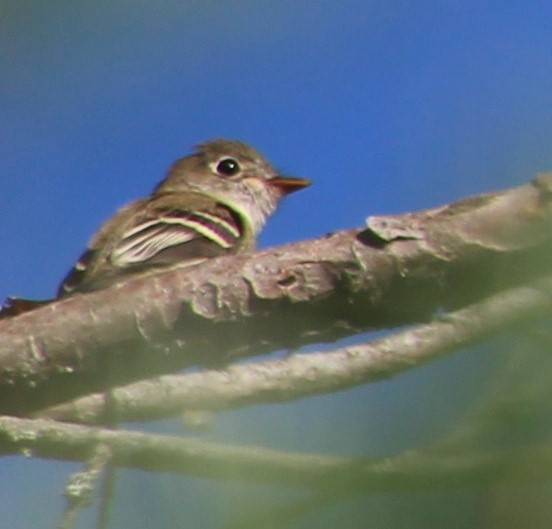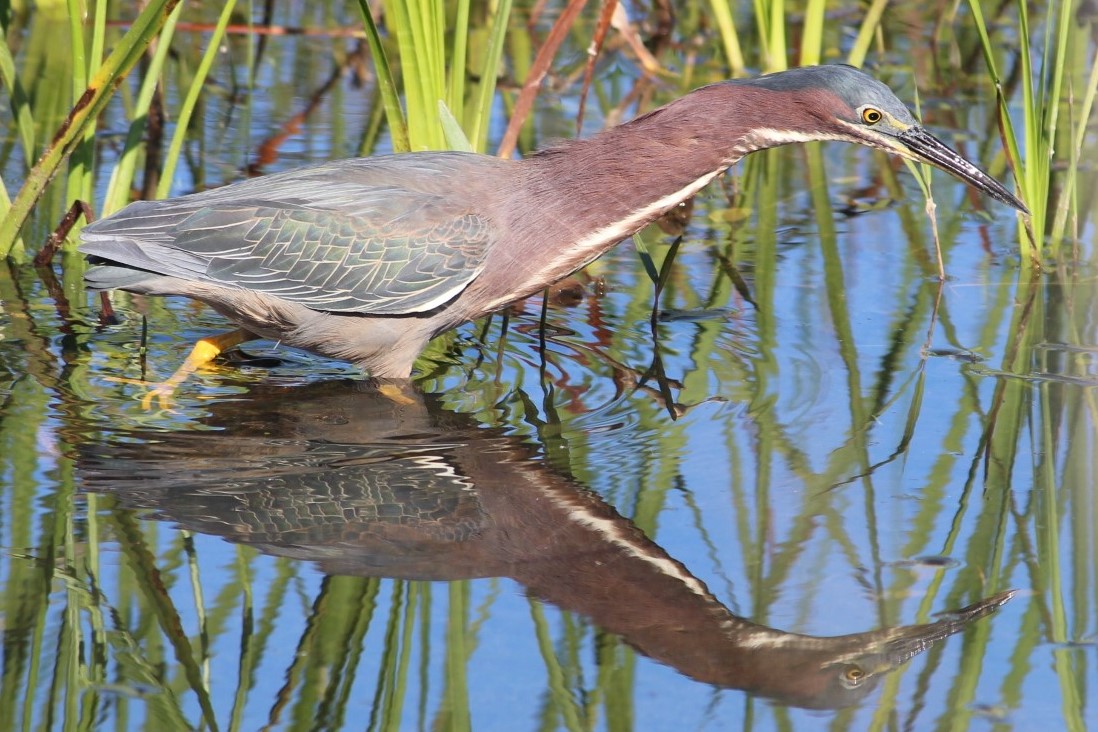One early morning in Algonquin Park, within the Pog Lake Campground, I took a walk to a river and a dam. Here, with the sun rising and the river flowing noisily over the dam, I could hear the faint little remarks of small songbirds zipping from branch-tip to branch-tip. I caught their colourful feathers reflecting the early morning light and from their frenetic foraging I identified them as members of that most energetic and wonderful group of birds known as Wood-Warblers (Family Parulidae). At least… most of them were Wood-Warblers. One avian exception was thrown into the mix.
From early morning visits in the light and an evening journey with fog muting the colours of the trees and birds, I spied and photographed 6 species of brids, some of them close enough to observe especially well. There was a tunnel formed of trees which created a surrounding of places for small birds to hop about me, sort of a shark tunnel for birding, with much less threatening subjects of observation. As the small birds moved about and around me I marveled at their bursts of flight and keen senses that enabled them to glean trees of insect inhabitants.
What follows is a swift tour through the birds I observed and photographed at this wonderful location, a flyby if you will.
Least Flycatcher (Empidonax minimus):

The one non-warbler was a Least Flycatcher (Empidonax minimus), another migratory bird but only very distantly related to the Wood-Warblers. Least Flycatchers appear in Ontario during May and usually leave by September (after breeding), setting off for their wintering grounds in Mexico and Central America (Tozer 2012). They are very common and widespread in Ontario during their stay, but are not often noticed, at least by me.
Magnolia Warbler (Setophaga magnolia):

Magnolia Warblers spend their breeding season, from about May to September nesting along the edges of forests of conifers or mixed trees (Tozer 2012). These beautiful birds are striking for their bright yellow undersides and was originally named the “Black-and-yellow Warbler” but is now more commonly called the Magnolia Warbler. Below is an excellent little window into one ornithologist’s encounter with these birds at the end of the 19th century. I think this piece of writing by William Brewster (Brewster 1877) captures some of the wonder I feel whenever I encounter warblers:
“At length, entering a grove of thick growing young spruces, I sat down to rest on a mossy log. I had been there but a short time when I became conscious of faint sounds in the trees above and around me, — chirpings, twitterings, and occasionally a modest little effort at song. Watching attentively, I soon spied a movement among the branches, and a tiny bird hopped out into the light, presenting a bright yellow breast and throat for just a moment before flying into the next tree, Here was a revelation ! I already knew a few of the most familiar birds, — the Robin, the Bluebird, the Sparrow, the Oriole, and some others; but it had never occurred to me that dark forests like these might be tenanted by such delicate and beautiful forms. Only the tropics surely could boast such gems.”
Yellow-rumped Warbler (Setophaga coronata):

Yellow-rumped Warblers are generalist warblers, using a variety of coniferous and mixed forests for their nesting habitat, and foraging with varied techniques including fly-catching and gleaning (Tozer 2012). These generalist habits make them a common sight, and that’s certainly a cause for celebration as their flitting trails through the foliage are wonderful to watch. Yellow-rumped Warblers have been sighted in Algonquin Park into November, but normally they depart for their United States wintering range during October (Tozer 2012).

Chestnut-sided Warbler (Setophaga pensylvanica):

While the preceding Warblers use conifers for nesting, the Chestnut-sided Warbler prefers open secondary forests and shrublands, historically caused by fire and more recently caused by human disturbances such as logging (Tozer 2012). Indeed, as humans have changed the forests of North America, these colorful birds have become more common as their preferred habitat has spread. Chapman (1917) writes: “The Chestnut-sided Warbler, for example, considered by Wilson and Audubon to be a rare species, is now abundant, and we may believe that this change in numbers is due largely to the development of those scrub and second growths in which the bird delights.”


American Redstart (Setophaga ruticilla):

“If a bird exists which is more constantly in motion and in a greater variety of ways, I have yet to see it.” – Frank Chapman, in Warblers of North America (1917).
The first several times I observed American Redstarts, I didn’t realize they were Wood-Warblers. I think the very dark and bright coloration didn’t match my association of Parulids with generally yellows and pale blues or white. The females are green-grey and yellow and white so they seem more in line with my description above, but the males are unmistakably distinctive. My first remembered encounter with Redstarts was in MacGregor Provincial Park (you can read about it here). They are memorable not just for their striking coloration but for their rapid foraging style, described beautifully by Chapman (1917) as “a mad series of darts and dives and whirls, of onward rushes and as sudden stops”.
Black-and-white Warbler (Mniotilta varia)

Similar to the American Redstart, the Black-and-white Warbler seems to be an odd one in the group appearance-wise. This monochromatic species also displays a different foraging strategy than the frenetic foliage-gleaning and hovering more typical of the Wood-Warblers. The Black-and-white Warbler forages much more similarly to a Nuthatch (Sitta sp.) or Brown Creeper (Certhia americana), crawling up and down trees and branches, using its elongated hind-claw and shorter legs to do so (Tozer 2012). The scientific name of this bird translates as “variegated moss-plucker”, in reference to their foraging methods (Hughes 2001). Another surprise from this small bird is that the “nest is usually located on the ground, often in a depression at the base of a tree, stump, or shrub, or under logs or dead branches” (Tozer 2012). What an amazing creature.

The Wood-Warblers I observed (and the Least Flycatcher too), all arrive in Algonquin in Spring and depart in the Fall; they use the resources of the northern forests swiftly before retreating to southern ranges as winter approaches. I’m glad I was present to see and capture their foraging, flitting, forms among the branches and tree trunks of the riverside in Pog Lake campground, and going through these photos again makes me look forward to their return this Spring.

References:
Brewster, William. “THE BLACK-AND-YELLOW WARBLER (DENDRŒCA MACULOSA).” Bulletin of the Nuttall Ornithological Club 2, no. 1 (1877): 1–7. http://www.jstor.org/stable/24723498.
Chapman, Frank. 1917. The Warblers of North America. Dover edition, 1968.
Hughes, Janice M. 2001. The ROM Field Guide to Birds of Ontario. Royal Ontario Museum.
Tozer, Ron. 2012. Birds of Algonquin Park. The Friends of Algonquin Park.
For Previous Algonquin Observation posts, see:
–Lakeside Lives (Algonquin Observations August 2023, Part 2)
–Campsite Companions (Algonquin Observations August 2023, Part 1)
–Canada Jay (Perisoreus canadensis)
–Algonquin Observations, Part 5 – Spruce Bog: The Reckoning
–Algonquin Observations, Part 4 – Spruce Bog Speedrun and the Logging Museum Trail
–Algonquin Observations, Part 3 – Peck Lake Trail








